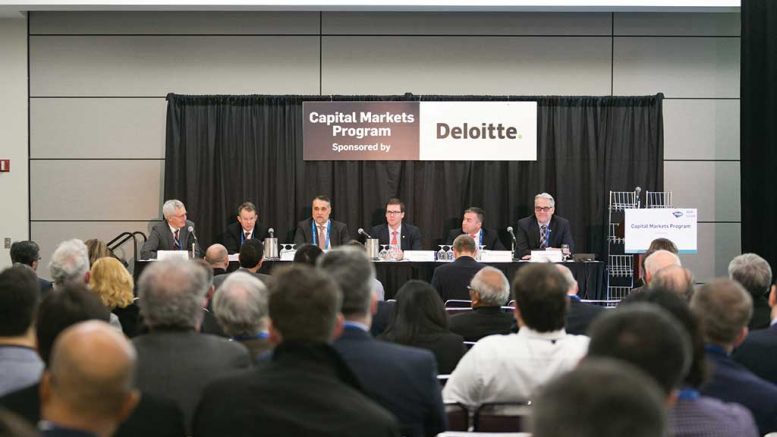Strategic private placements, private equity and joint-venture partnerships are playing a bigger role in financing exploration and development projects in the mining sector, a group of Canadian bankers agreed during a panel discussion at the Prospectors & Developers Association of Canada convention in Toronto.
“It’s a pretty interesting shift both on how juniors are trying to finance their business and also how larger companies are trying to grow,” Chris Gratias of CIBC Capital Markets said in his opening remarks.
If you look at the amount of capital raised between 2013 and 2015 by the juniors — companies he categorized as having a less than $500-million market capitalization — 80–85% of it would have come from the public markets or investors, he said, and 15% would have come from strategic private placements. In the last 12–18 months, by contrast, 60% has come from strategic private placements and 40% from the public markets.
“Through the last cycle I would say a lot of the development was funded through the equity markets, and I don’t think that will be the case through this next cycle going forward, and that has caused alternative forms of capital to position themselves,” he said. “We’ve seen an increased presence of private equity that is providing alternative forms of capital, we’ve seen pension funds and sovereign wealth funds spending their time in the space, and, very interestingly, we’ve seen the corporates playing a financing role for the junior market. We call these strategic private placements — it’s almost an alternative form of exploration. Instead of doing it in-house, they’re outsourcing it by backing a junior public company.”
That doesn’t mean the public markets aren’t available to raise capital, Gratias added. “They are there — it’s just in smaller size and higher discounts, so it’s expensive capital.”
Another trend in the current cycle is that the industry hasn’t seen capital flow back into the actively managed mining funds. “Assets under management for mining specialty funds are down probably 50% from the peak,” Gratias said. “And you probably have half of the number of funds still in existence. You’ve got fewer funds and the ones that are left have less money. They want to be active but they don’t have the money to be active. If they want to buy the dip, they need to sell something. We need to see money flow back into the mining specialty funds.”
Peter Collibee of Scotia Capital Inc. pointed out that commodity prices aren’t the problem. “The industry needs to take a good look at itself,” he cautioned. “In terms of rates of return, there have been many, many examples of poor rates of return. In many cases, significant negative rates of return. People have lost lots of money, so there are some fundamental reasons why the equity markets are as challenged as they are, particularly for juniors and the mid-tier gold space. Risk mitigation through partnerships — both on megaprojects but even on smaller projects — that is part of the industry responding to the demand, and the legitimate demand, from the investing community for better rates of return.”

The Investors Exchange at PDAC in Toronto. Photo by The Northern Miner.
Rick McCreary of TD Securities noted that partnerships in the base metals space have been around for years, and now there are finally signs that gold companies are beginning to understand their importance in terms of sharing risk, taking advantage of synergies and not duplicating costs.
Barrick Gold, for instance, has pursued four joint-venture partnerships since it arranged its first with Goldcorp at its Pueblo Viejo mine in the Dominican Republic, he said. Since then, it has partnered with Shandong Gold in a fifty-fifty joint venture at its Veladero mine in Argentina; is involved in a fifty-fifty joint-venture at the Jabal Sayid project in Saudi Arabia, with Saudi Arabian Mining Co. (Ma’aden); has set up a fifty-fifty joint venture in Papua New Guinea at Porgera, with Zijin Mining; and has teamed up in a fifty-fifty joint venture in Chile, with Antofagasta at Zaldivar.
“The gold sector has finally figured out it’s better to work together than to compete, especially when the projects are increasingly difficult, and by putting two people together and/or two assets together, you can basically reduce the environmental footprint, the capital and improve returns,” McCreary said.
Private equity is also playing a greater role than ever before, the bankers agreed.
“We now have a number of very, very savvy resource private equity groups, and there are a handful of them that are providing significant amounts of capital, and maybe there will be two handfuls in two years’ time if the market stays at this level,” Scotia Capital’s Collibee said. “They are providing capital across the balance sheet. Their returns have been attractive. Their capital doesn’t come free or cheaply, but it certainly is competitive in the context of what other capital is available.”
While there are still some banks providing project financing, many have left that business, and like equity financing, project financing is playing a smaller part.
As evidence, Collibee noted that of the US$3 billion of capital needed to fund Lundin Gold’s Fruta del Norte project, Lydian’s Amulsar, Pretium’s Brucejack and Stornoway’s Renard, 10% came from project finance, 10% or 15% from public markets, and the other 70–80% from private equity funds.
“It could be the private equity funds providing traditional debt, streams and putting equity into projects, but that much came out of the private equity market,” Collibee said. “We can see by looking at those four projects how the world has changed.”
Egizio Bianchini of BMO Capital Markets (in one of his final appearances for BMO before he departs) agreed. “The way money is raised for exploration is changing. The way money is raised for development is changing … the water is finding different ways to flow downhill.”
Risk capital has gone up, he said, but the world needs to invest in junior mining companies — now perhaps more than ever — to meet society’s needs.
“We’re heading into a new age of metals. We’re going to need more copper, cobalt, vanadium and scandium. Whatever it is, we’re going to need it.”





Be the first to comment on "PDAC 2018: Bankers on lessons learned, exploration, finance trends"